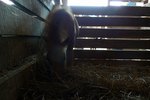
Only broodmares and stallions absolutely require the increased space that box stalls provide, but most horses benefit from it. The ASPCA says straight stalls aren't necessarily and are worse than box stalls. Straight stalls provide added benefits for horse owners but few benefits for horses themselves. Box stalls are more labor-intensive and time-consuming to clean and maintain, but they provide horses with greater freedom of movement. Such benefits promote horse health and limit risk of behavior problems.
Straight vs. Box
Straight stalls are sometimes called tie stalls because the horse's head is tied to the front of the stall. Straight stalls measure approximately 45 square feet, or 5 feet by 9 feet. The standard size for a box stall, meanwhile, is 12 feet by 12 feet -- 144 square feet -- ponies and smaller horses may be kept in 10-by-10-foot or 10-by-12-foot box stalls. Stallions require more space; their stalls are generally 14 feet by 14 feet.
Benefits of Box Stalls
Box stalls have benefits. Horses kept in box stalls are not tied up inside the stall. They are free to move about in the stall and to lie down. While horses can sleep standing up, according to the ASPCA, they achieve REM sleep only while lying down. Horses that have more freedom of movement tend to exhibit fewer behavioral problems than horses kept strictly confined. According to the Merck Veterinary Manual, confined horses can develop behavioral problems such as stall walking or circling, cribbing, kicking or weaving.
Drawbacks of Box Stalls
Box stalls also have drawbacks. They take up more space than straight stalls, so you can keep fewer horses in a single barn. Box stalls require more square feet of bedding, adding to the horse owner's costs. Because horses can move about freely within a box stall, they urinate and defecate wherever. Horse owners must take more time to find and remove soiled bedding each day.
When Box Stalls Are Necessary
Box stalls are necessary for broodmares or mares and their foals. Broodmares need space to move about freely and stretch out on the stall floor when giving birth. In a stall too small, the mare risks stepping on her foal. A 12-by-12-foot box stall is acceptable as a foaling stall, but a larger stall is preferable. You can make a large foaling stall by removing the partition between two box stalls, creating one large box stall of about 24 by 12 feet.
References
- Penn State College of Agricultural Sciences: Horse Facilities,: Horse Stall Design
- Northeast Recycling Council: Guidelines and Best Practices for Horsekeeping
- ASPCA: General Horse Care
- America's Horse Daily: Ask an Expert: "Stall Confinement"
- Draft Animal Power: Tie Stall vs. Box Stall
- Equisearch: Create a Safe Foaling Stall
- The Merck Veterinary Manual: Behavioral Problems
Photo Credits
-
George Doyle/Stockbyte/Getty Images
Writer Bio
Jeanne Grunert has been a writer since 1990. Covering business, marketing, gardening and health topics, her work has appeared in the "Chicken Soup for the Soul" books, "Horse Illustrated" and many national publications. Grunert earned her Master of Arts in writing from Queens College and a Master of Science in direct and interactive marketing from New York University.




